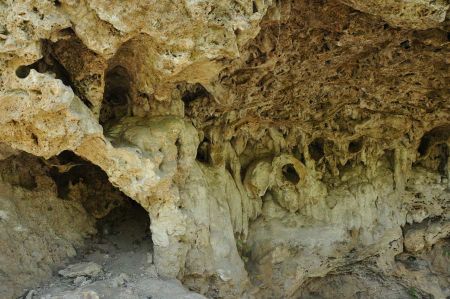Open air Stalactite formations at Dursunbey Cayi
- Written by Portal Editor
During our exploration along the Dursunbey Cayi, we came across a small stream which was to pass by car before we could reach into a rich, green lawn that was used by backpack hikers traveling with a tent during these days.
A great location for campers or the target for a mountain tour, so we were thinking.
Our local guide took us straight onto a narrow path into the actual valley of Dursunbey Cayi where we should encounter some impressive open air stalactites. Mostly occurring in caves, it differs in the course of Dursunbey Cayi where the cave systems was flushed by the changing direction of the river, and thus can be visited now just by passing by. Stalactites are formed when rain absorbs carbon dioxide from the atmosphere, then seeps into the ground and receives organic acids there. As a result, the limestone calcium carbonate (lime) dissolved in the water. The dissolved lime connects with the carbon dioxide to calcium bicarbonate, which is highly soluble in water.
Upon reaching a cave ceiling, this mixture drips through existing crevices. When now the carbon dioxide escapes occurring ingress of air, the calcium bicarbonate is converted back into the poorly water-soluble calcium carbonate. The water evaporates, remains of lime forming the stalactites in the course of millennia. The evaporation of the water, however, plays a role in only a few caves or at cave entrances. By dissolved minerals in the water, speleothems may have different colorations.
Here on the riverbank there was an area which has been formed by a small waterfall by surface water that had lead to further stalactites, which were now green, covered with moss. One speaks, depending on the arrangement of the stalagmite, of stalactites or stalagmites, another term is used less in common parlance, since the continuous column form is relatively rare.
While the carbonated water flows through the karst, it dissolves the limestone to full saturation into itself. If it then impinges on a cavity, the water flows along the ceiling, loses its flow rate and forms drops due to the surface tension. Sintered lime forms the hanging type of sculptures from the ceiling, the stalactites. The incident dropping to the ground still contains some lime. Upon impact of the drop CO2 is again released and lime precipitates. According to this another sculpture from the floor grows in height and forms a stalagmite. Stalagmites and stalactites can grow together as a column and then are called stalagnate. Speleothems arise, however, not only of lime.
In English, the following award helps: "stalagmites grow from the ground, stalactites come from the ceiling", "monte La stalagmite, stalactite la tombe" in French (monter "rise" and tombe "fall").
Speleothems develop and grow seen in the human scale very slowly. The exact speed of the stalactite growth, however, varies and depends on several factors:
• lime concentration in water
• CO2 content in the water and in the cave
• amount of dripping water
• temperature
The environmental conditions have decisive influence on the growth of stalactites. Growth rates vary with climatic changes, since this change indicates above four parameters. Alternating between cold periods and warm periods, growth varies considerably. During a cold period, it may, by the sealing of the soil due to the formation of permafrost, be an interruption of growth. In the last interglacial period it was warmer and wetter than it is today, so the growth rates may have been higher.
The growth of stalactites can be disturbed by cave visitors. When the user touches a stalactite, then fat is on the skin of the natural sculpture and prevents future calcification at this point.
Please read as well:
Exploration Trip to Dursunbey - unspoiled nature awaiting us
Sultan Ahmet Mosque - Blue Mosque in Istanbul
-
-
-
-
-
-
-
-
-
-
-
-
-
-
-
-
-
-
-
-
-
https://www.alaturka.info/en/turkey-country/marmara-region/3298-open-air-stalactite-formations-at-dursunbey-cayi/amp#sigProIded73ce54d5
